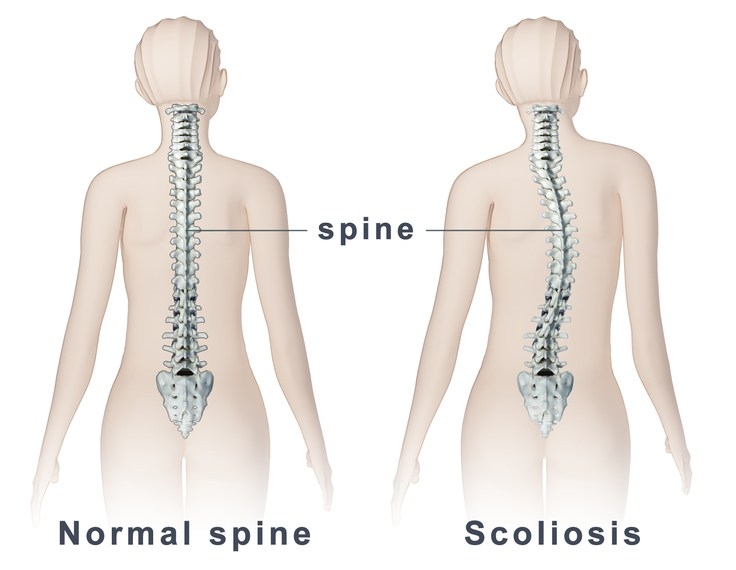
Scoliosis in simple terms is defined as a condition in which a three-dimensional change is noticed in the spine's alignment, i.e., curve. It is a neuron muscular and multifaceted condition which challenged many healthcare professionals worldwide. It is a broad term which portrays a spinal curve of 15 degrees and more than 50 degrees. To heal your injury you need to take regular physiotherapy classes from PAL Physiotherapy one of the best Scoliosis Physiotherapy Centre in Gurgaon from talented and well experienced physiotherapists. Patients experiencing this condition lose some curve in their necks which result in a forward-tilted head posture. The sideway curve if greater than 10 degree leads ribcage to twist.
There are mainly four types of Scoliosis -
Idiopathic Scoliosis
It is known as the most common type of Scoliosis and can be seen in any age group.
Congenital Scoliosis
It is a rare Scoliosis which affects one in 10000 kids in utero
Neuromuscular/myopathic Scoliosis
It occurs mainly in children those who have neuromuscular disorders such as cerebral palsy/ muscular dystrophy.
Degenerative Scoliosis
This type of Scoliosis mainly occurs after the age of 65 years and above and is recognized as adult Scoliosis.
Scoliosis is a condition in which your spine is curved from side to side or in S or C shape. However, the normal shape of the spine includes a curve at the top of the shoulder as well as a curve at a lower back. Most Scoliosis cases do not have any identifiable cause and can be diagnosed during the first seven years of children life. Some common causes of Scoliosis are -
Scoliosis often appears in children and causes the spine to curve. Some common symptoms of Scoliosis in infants are -
The most common type of Scoliosis appears in adults known as Adolescent Idiopathic Scoliosis and can affect from ten years of age. Symptoms are -
Diagnosis of Scoliosis can be confirmed after detailed medical history and some tests.
Physical examination- During the physical examination doctor may make a child stand and also bend forward from the waist with loose arms. By this, he/she will observe if one side of the ribcage is more prominent than other.
Neurological examination- The doctor can also perform this to check abnormal reflexes, numbness and muscle weakness
X rays- It is done to confirm and reveal the severity of the spinal curve. It will be a standing X-ray to observe the entire spine from back to the side.
Mostly treatment of Scoliosis in Gurgaon includes bracing as well as physiotherapy. Treatment is based on the degree of curve, the age of the patient, sex, and bone maturity. Very fewer patients of Scoliosis require surgery. The primary objective of treatment of Scoliosis will be to stop the progression of the curve and also to prevent deformity. Treatments include bracing, surgery and physiotherapy.
Among all these physiotherapies is considered to be one of the best and safest ways to treat Scoliosis. It is recognized as the most effective treatment for Scoliosis. The condition of the patient can be improved by Physiotherapy treatment of Scoliosis a lot as it focuses on muscle imbalances as well as many other factors leading to excessive spinal curvatures.
Physiotherapy will help you to attain greater elasticity in muscles that are tight and short and will also build up the long and weak muscles. Physiotherapy can treat both types of patients those who are using braces and those who are not using braces. A physiotherapist will consider many vital points before developing treatment plans for Scoliosis. He/she will consider:
An indispensable physiotherapy exercise is the conservative three-dimensional Schroth method. Scoliosis physiotherapy in Gurgaon consists of curve-specific exercises and corrective breathing techniques. The general goal of these exercises is to de-rotate, deflex and to correct the spine in the sagittal plane while elongating the spine.
In addition to that, the patient needs to be highly focused on re-establishing spinal symmetry. Correcting the spine is, in fact, the key to a successful therapy.
Scoliosis is a deformity in which a person’s spine is not straight but is curved. Women are more prone to this condition in comparison to men. There are many ways by which you can prevent Scoliosis. They are -
Avoid poor postures
People having wrong postures generally develop Scoliosis, thus people should avoid sitting or walking in wrong postures. To prevent poor postures prevent getting the spine blended from side to side.
Don’t overexert on a single side
Avoid doing activities that exert only a single side as it is one of the main causes of Scoliosis. Some changes can avoid the condition like carrying bags on both shoulders; sportsperson should use both hands while playing.
Exercising back muscles
One of the best ways to prevent Scoliosis is to start back exercises. It will result in a healthy spine.
Consume calcium-rich food
Start consuming calcium-rich foods as they will keep bone healthy especially intake of Vitamin D is very important.
